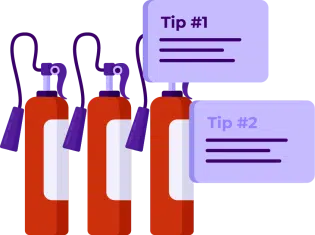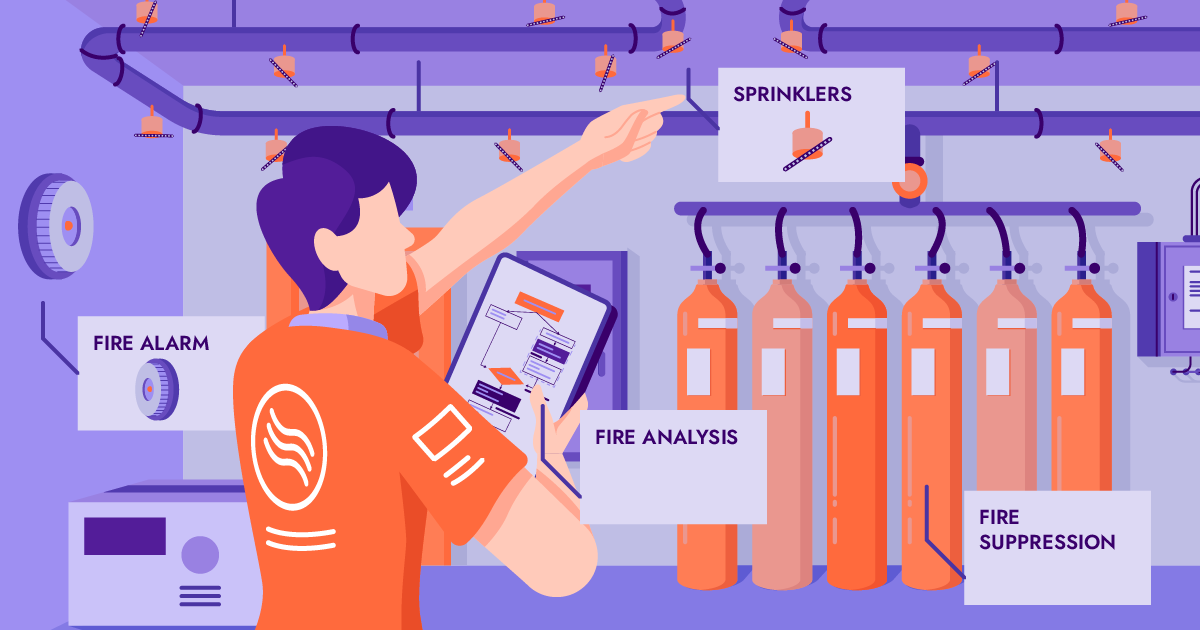A Guide to Expert Fire Extinguisher Testing for Field Service Businesses

The fire safety industry is essential to ensuring critical fire fighting equipment is being maintained. Whether it’s installing fire sprinkler systems, inspecting wet chemical fire extinguishers, or portable fire extinguishers, or even doing routine checks of general fire safety equipment, it’s vital to have the right tools for both your field teams and your office base.
Let’s break down some key fire equipment points to add to your checklist:
Understanding Regulatory Compliance of Fire Extinguishers
Field service businesses must operate in compliance with local and national safety regulations. Familiarize yourself with the specific requirements in your region regarding fire extinguisher testing. Regulations may include regular inspections, testing intervals, and certification standards. Staying compliant not only ensures the safety of your workplace but also avoids potential legal consequences.
Developing a Comprehensive Testing Schedule
Establishing a routine testing schedule is crucial for maintaining fire extinguishers in optimal condition. Develop a plan that outlines when each extinguisher should be inspected, tested, and serviced. Consider factors such as the type of extinguisher, environmental conditions, and the specific needs of your field service business. Regular testing intervals might range from monthly visual inspections to annual thorough examinations.
Training Your Field Service Team
Ensure that your field service team is adequately trained in fire extinguisher testing procedures. Training should cover visual inspections, functional tests, and more extensive maintenance tasks. Keep your team up-to-date on the latest safety standards and any changes in regulations. Well-trained technicians not only enhance workplace safety but also contribute to the credibility and professionalism of your field service business.
Visual Inspections
Monthly visual inspections are a quick but essential step in fire extinguisher testing. During these checks, technicians should look for obvious signs of damage, corrosion, or tampering. Verify that the extinguisher is in its designated location and that the pressure gauge falls within the acceptable range.
Functional Testing
Regularly conduct functional tests to ensure that all fire extinguishers meet fire safety requirements and operate correctly. This may involve discharging a small amount of the extinguishing agent to verify proper discharge and pressure. Functional testing helps identify any potential issues before they become critical in an emergency.
Hydrostatic Testing
Certain types of fire extinguishers require periodic hydrostatic testing to assess the integrity of the pressure vessel. This in-depth examination is typically conducted every few years and ensures that the extinguisher can withstand the pressures it may encounter during use.
Fire Extinguisher Documentation and Record-Keeping
Maintain thorough documentation of all fire safety assessment and fire extinguisher testing activities. This includes details such as inspection dates, test results, and any maintenance or repairs performed. Proper record-keeping not only demonstrates regulatory compliance but also serves as a valuable reference for future inspections and audits.
Selecting the Right Fire Extinguisher for Various Fire Classes
When it comes to fire safety, understanding the right type of fire extinguisher for different scenarios is crucial. Different classes of fires require specific extinguishing agents to be effectively controlled or extinguished. Let’s explore the key considerations for selecting the right fire extinguisher, keeping in mind the diverse settings of field service businesses.
1. Class E Fires – Electrical Equipment:
Field service businesses often involve the use of electrical equipment, making the risk of Class E fires significant. For such scenarios, it is essential to choose fire extinguishers that are specifically designed for electrical fires. These extinguishers typically use non-conductive agents, such as dry chemical powder, to suppress the fire without causing harm to the electrical components.
2. Flammable Liquids and Metals:
In environments where flammable liquids or metals are present, the choice of fire extinguisher becomes critical. Class B fires involve flammable liquids, while certain metals require specialized extinguishing agents. Understanding the nature of the materials involved in your field service operations will guide the selection of the appropriate fire extinguisher, ensuring effective fire protection.
3. Cooking Oils and Flammable Materials:
For field service businesses that deal with cooking oils or other flammable materials, having the right fire protection measures in place is paramount. Consider using fire extinguishers with specialized agents designed to tackle Class K fires, commonly associated with cooking oils and fats. These extinguishers are effective in preventing re-ignition and minimizing damage.
4. Routine Inspections and Maintenance:
Routine inspections play a pivotal role in ensuring the reliability of fire extinguishers. Regularly assess the condition of extinguishers, checking for visible damage, proper pressure, and accessibility. Incorporate these inspections into your field service business’s maintenance routine to guarantee that fire safety requirements are consistently met.
5. Adhering to Australian Standards:
In the context of field service businesses operating in Australia, compliance with Australian Standards is non-negotiable. Familiarize yourself with the specific standards related to fire extinguishers, ensuring that your selection, installation, and maintenance align with these guidelines. This commitment not only enhances safety but also positions your business as one that prioritizes regulatory compliance.
6. Tailoring Solutions for Different Environments:
Whether your field service activities occur in an office building, commercial premises, or an industrial site, customizing fire protection measures is essential. Evaluate the unique risks associated with each environment and choose fire extinguishers accordingly. This tailored approach ensures that your fire safety measures are effective in diverse settings.
The Platform for Essential Fire Safety Services
In the dynamic world of field service businesses, prioritizing fire extinguisher testing and optimising fire assets is a non-negotiable element of safety management. By understanding and adhering to regulatory requirements, developing a comprehensive testing schedule, training your team, and documenting activities, you can ensure that your fire extinguishers are reliable and ready to respond in the event of an emergency. Taking these proactive measures not only protects lives and property but also strengthens the overall safety culture of your field service business.
What Makes FieldInsight Different?
Whether you are looking to gain back your wasted time, or grow your business, a FSM software is the right path to take. But how do you choose what field service management software is right for you?
FieldInsight differs from the other competitors with the flexibility of the implementation and features. FieldInsight’s key features and benefits include:
- Asset information and management
- Store key business information
- Scheduling
- SWMS and safety management
- Timesheet management and field time tracking
- Boost relationships with customers
- Project management
- Track equipment and maintenance
- Manage multiple sites
- Preventive maintenance and repeat service jobs
- Track common issues and defects
- Inventory management
- Manage field staff availability and resources
- Project portfolio management
- Easy file sharing
- Integration features
- Customisable reports and collaboration tools
- and many other benefits
Systemise your business and manage your business without jumping from software to software. With FieldInsight all you ever need is a few clicks away.
Find out more about what FieldInsight can do for you. What have you got to lose?
What You Should Do Now
- Book a Demo. You’ll be in touch with an automation expert who has worked in this space for over 5 years, and knows the optimal workflow to address your needs.
- If you’d like access to free articles about managing HVAC workflows, go to our blog.
- If you know someone who’d enjoy reading this page, share it with them via email, Linkedin, Twitter, or Facebook.








